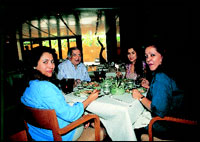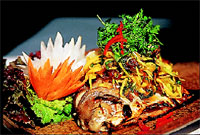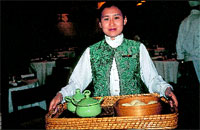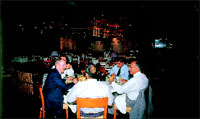


|
The Orient Comes A-calling On India Jones
|
|
A LOT of people after dining at India Jones, the Oberoi Towers� new multi-cuisine restaurant in Bombay, want to know who India Jones is. The story being put out by the hotel is that Bharrat (India) Joyent (Jones), an intrepid traveller with a passion for food, was born on August 15, 1947, in Cheerapunji where it always rains. He studied in America, changed his name but not his character, and developed a fondness for travel and a love of fine cuisine. India Jones�s adventures took him far and wide. He maintained diaries, collected recipes, and he befriended chefs. When he returned to India, he set up a home in Bombay that he kept open for fellow journeymen who shared his zest for life and passion for food. This home is the India Jones restaurant.
That�s the hotel�s story. I think India Jones is Sanjiv Malhotra, the vice-president of the Oberoi Group of Hotels, who conceptualised this South-East Asian fine wining and dining restaurant. India Jones was designed according to his plans by New York architect Toni Chi. He is one of the best in the world. Restaurants in the US and all over Asia are slowly being recognised first for Toni�s interiors and then the food. The F&B consultant was Roland Gaelens of Belgium, one of the leading faculty of the famous Paul Bacouse School of Cooking. He had already helped the Oberoi set up its Frangipani restaurant next door.
When you go there for dinner, before you sit down to eat, take a walk around the kitchen. If Manish is on duty, ask him to show you around. It is an open kitchen. And one not divided according to the cuisines, but on cooking techniques. But first, the multi-cuisine menu: it is made up of food from Malaysia, Thailand, Indonesia, Vietnam, China, the Pacific Rim and India. One section of the kitchen is for curries, another for stir-fry dishes, a third for salads and appetisers. The kitchen staff are all fresh from the market. Rather than take old Oberoi hands, Manish decided to hire newcomers and mould them they way the restaurant needed them to be. But I have distracted you from your kitchen tour.
I will finish telling you about the seafood before going onto the rest of the menu. The Grouper is a delicacy and most popular at India Jones. It is steamed with soy and ginger broth and enhanced with sesame oil. However, most Indians don�t ask for it. I suspect they don�t know what the Grouper is. �Why is there no Pomfret in the tank,� I asked Manish. �It is a deep sea fish,� he explained, �and we can�t get it out live. The moment the Pomfret comes to the surface, its lungs rupture, and it dies.� So the pomfret is kept frozen. As is the Red Snapper, the Norwegian Salmon, the Cuttle from Bangkok and the Scallops from New Zealand. The crab and spiny lobster, which come from Kerala, are kept in one of the tanks. You ask for a closer look at the crab, and a chef will fish one out for your inspection, its talons hooking the empty air. If you give the restaurant two days� notice, it will source out Tuna and squid for a sashimi and sushi meal.
I will not attempt to describe the food, 124 dishes, plus, plus, is too much to talk about. No eating out column would be able to do justice to such a menu. Or, for that matter, to any one cuisine in the restaurant and the flamboyant chef making it for you. Instead, I will recommend that you go to India Jones for dinner. It is a celebration restaurant. The kind of place where people plan an evening out on special occasions. You will have to reserve a table for the restaurant is going full. Ninety per cent of the clientele has been there before and wants to come again. I suppose, it will take five years to sample something of the 124 dishes. That�s how long Chef de Cuisine Manish Nambiar plans to retain the existing menu.
India Jones,
Saffron
|

Home Page
About the mag
Subscribe
Advertise
Contact Us
 The new multi-cuisine restaurant at The Oberoi is really the proverbial melting pot of international foods, discovers MARK MANUEL.
The new multi-cuisine restaurant at The Oberoi is really the proverbial melting pot of international foods, discovers MARK MANUEL.
 The story is now taken up by India Jones�s young and enterprising chef de cuisine, Manish Nambiar. The Oberoi sent him on a gourmet journey all over South-East Asia so that he might be exposed to its many cuisines and see what was compatible with the Bombay palate. And also to identify chefs for the new restaurant, source out suppliers for food ingredients, cutlery and crockery. For one-and-half year Manish travelled all over Thailand, HongKong, Indonesia, Vietnam, Singapore, China, Malaysia doing just that. When he had made all his choices, Sanjiv Malhotra joined him on a whirlwind two-week recce, and they came back with recipes for a menu of seven cuisines. Plus, four young expat chefs to prepare this menu. They are Vikan Nambises for the Teppanyaki table; Anthony Hueng for Chinese food; Cao Ming Chi for Vietnamese; Pornchai for Thai.
The story is now taken up by India Jones�s young and enterprising chef de cuisine, Manish Nambiar. The Oberoi sent him on a gourmet journey all over South-East Asia so that he might be exposed to its many cuisines and see what was compatible with the Bombay palate. And also to identify chefs for the new restaurant, source out suppliers for food ingredients, cutlery and crockery. For one-and-half year Manish travelled all over Thailand, HongKong, Indonesia, Vietnam, Singapore, China, Malaysia doing just that. When he had made all his choices, Sanjiv Malhotra joined him on a whirlwind two-week recce, and they came back with recipes for a menu of seven cuisines. Plus, four young expat chefs to prepare this menu. They are Vikan Nambises for the Teppanyaki table; Anthony Hueng for Chinese food; Cao Ming Chi for Vietnamese; Pornchai for Thai. You must inspect the live seafood and point out what you want for your meal. Most of the seafood comes from Kochi and Vishakapatnam. India Jones has got two marine tanks from Australia in which the seafood is kept. These tanks are expensive, they maintain their own PH and salt levels for two years, all the restaurant staff has to do is check them and adjust the salinity to suit different fish. They are holding tanks and not meant for display, which is why they are in the kitchen, not the front of the restaurant. �We don�t want to upset the veggies,� Manish said. Good thing they are in the back area, too. For the prize exhibit in the tanks is the Grouper. And to net this fish after you have identified one for your meal, the chef has a fight on his hands. The night I was there, both, the chef and I got thoroughly drenched in the Grouper�s struggles.
You must inspect the live seafood and point out what you want for your meal. Most of the seafood comes from Kochi and Vishakapatnam. India Jones has got two marine tanks from Australia in which the seafood is kept. These tanks are expensive, they maintain their own PH and salt levels for two years, all the restaurant staff has to do is check them and adjust the salinity to suit different fish. They are holding tanks and not meant for display, which is why they are in the kitchen, not the front of the restaurant. �We don�t want to upset the veggies,� Manish said. Good thing they are in the back area, too. For the prize exhibit in the tanks is the Grouper. And to net this fish after you have identified one for your meal, the chef has a fight on his hands. The night I was there, both, the chef and I got thoroughly drenched in the Grouper�s struggles. I would suggest you go to India Jones late for dinner. Expats, mainly Korean and Japanese, flood the place for the first sitting, which is around 7.30 p.m. Go with an open mind, confident of having a good meal. Ask for help, call for Manish or the restaurant manager, the menu is too vast for you to decide for yourself. Unless you can make up your mind from the 124 dishes they have listed there which each have an identity of their own. There�s also a Japanese menu not on print for which the chef is always taking orders, and a special Korean menu that runs as well. �Still, we have Jains and Marwadis who want the food cooked their way,� said Manish. �We don�t look at what is right or wrong. How would you treat such guests at home? For us, this is a double-edged sword. Does the chef do what he wants or what the guest wants? Cook authentic Chinese not acceptable to the Indian? Or cook Chinese for a Jain that is not palatable to a Chinese? The chef crosses the threshold. There is no harm serving something that is not listed on the menu.�
So, there are six cuisines on the menu, Thai, Chinese, Vietnamese, Indonesian, Malaysian, and Teppanyaki from Japan, and Indian where the tandoor is used as a medium of cooking but where all the marinations are from the Pacific Rim. The essence of cooking at India Jones is that of Oriental cuisine. Where the food is cooked tenderly and has one predominant flavour. And where the freshness of the ingredient is most important. Whatever you eat there, you taste naturally; there is the flavour and taste of the natural ingredient. Manish, whose role is that of a sampler who journeys through the menu, says he tries to identify the tastes of each guest, especially what a person dislikes. Then he plans the menu so that the guest does not feel he is eating at a Thai or Chinese restaurant, but that he is at India Jones. Using a two-way Motorola walkie-talkie, Manish informs the kitchen of his order. And, eight minutes later, not longer, the food is at the guest�s table!
I would suggest you go to India Jones late for dinner. Expats, mainly Korean and Japanese, flood the place for the first sitting, which is around 7.30 p.m. Go with an open mind, confident of having a good meal. Ask for help, call for Manish or the restaurant manager, the menu is too vast for you to decide for yourself. Unless you can make up your mind from the 124 dishes they have listed there which each have an identity of their own. There�s also a Japanese menu not on print for which the chef is always taking orders, and a special Korean menu that runs as well. �Still, we have Jains and Marwadis who want the food cooked their way,� said Manish. �We don�t look at what is right or wrong. How would you treat such guests at home? For us, this is a double-edged sword. Does the chef do what he wants or what the guest wants? Cook authentic Chinese not acceptable to the Indian? Or cook Chinese for a Jain that is not palatable to a Chinese? The chef crosses the threshold. There is no harm serving something that is not listed on the menu.�
So, there are six cuisines on the menu, Thai, Chinese, Vietnamese, Indonesian, Malaysian, and Teppanyaki from Japan, and Indian where the tandoor is used as a medium of cooking but where all the marinations are from the Pacific Rim. The essence of cooking at India Jones is that of Oriental cuisine. Where the food is cooked tenderly and has one predominant flavour. And where the freshness of the ingredient is most important. Whatever you eat there, you taste naturally; there is the flavour and taste of the natural ingredient. Manish, whose role is that of a sampler who journeys through the menu, says he tries to identify the tastes of each guest, especially what a person dislikes. Then he plans the menu so that the guest does not feel he is eating at a Thai or Chinese restaurant, but that he is at India Jones. Using a two-way Motorola walkie-talkie, Manish informs the kitchen of his order. And, eight minutes later, not longer, the food is at the guest�s table!